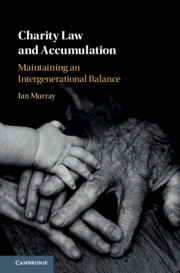Book contents
- Charity Law and Accumulation
- Charity Law and Accumulation
- Copyright page
- Contents
- Acknowledgements
- Table of Cases
- Table of Statutes
- List of Acronyms, Abbreviations and Frequently Cited Works
- Part I Charities and Accumulation Delineated
- Part II Charities and Accumulation Delimited
- Part III Charities and Accumulation Reformed
- 7 Intergenerational Justice and the Intergenerational Distribution of Benefits
- 8 Which Generation Decides the Intergenerational Distribution of Benefits?
- 9 Enhanced Agency Costs
- 10 Conclusion
- Index
7 - Intergenerational Justice and the Intergenerational Distribution of Benefits
from Part III - Charities and Accumulation Reformed
Published online by Cambridge University Press: 23 July 2021
- Charity Law and Accumulation
- Charity Law and Accumulation
- Copyright page
- Contents
- Acknowledgements
- Table of Cases
- Table of Statutes
- List of Acronyms, Abbreviations and Frequently Cited Works
- Part I Charities and Accumulation Delineated
- Part II Charities and Accumulation Delimited
- Part III Charities and Accumulation Reformed
- 7 Intergenerational Justice and the Intergenerational Distribution of Benefits
- 8 Which Generation Decides the Intergenerational Distribution of Benefits?
- 9 Enhanced Agency Costs
- 10 Conclusion
- Index
Summary
Chapter 7 recapitulates how Chapters 3 to 6 demonstrate that charity controllers are subject to a range of duties and mechanisms that ensure some regard be given to both present and future potential benefit recipients but that those duties and mechanisms largely lack a normative benchmark, such as intergenerational justice, to determine the timing of benefit distribution. Chapter 7 thus examines whether intergenerational justice could act as a normative basis for charity controllers’ choices about how to allocate benefits between current and future generations. It also considers the role that efficiency might play in such decision-making. The chapter then investigates the practicalities of attempting to incorporate principles of intergenerational justice into rules that constrain charity accumulation. Both general issues of practicality and specific reform options are considered. The aim is to better incorporate a normative basis for benefit distribution while at the same time protecting the potential benefits from accumulation and retaining consistency with the goals of charity law. Examples are drawn from the United States, Australia, Canada and the United Kingdom.
Keywords
- Type
- Chapter
- Information
- Charity Law and AccumulationMaintaining an Intergenerational Balance, pp. 193 - 224Publisher: Cambridge University PressPrint publication year: 2021

